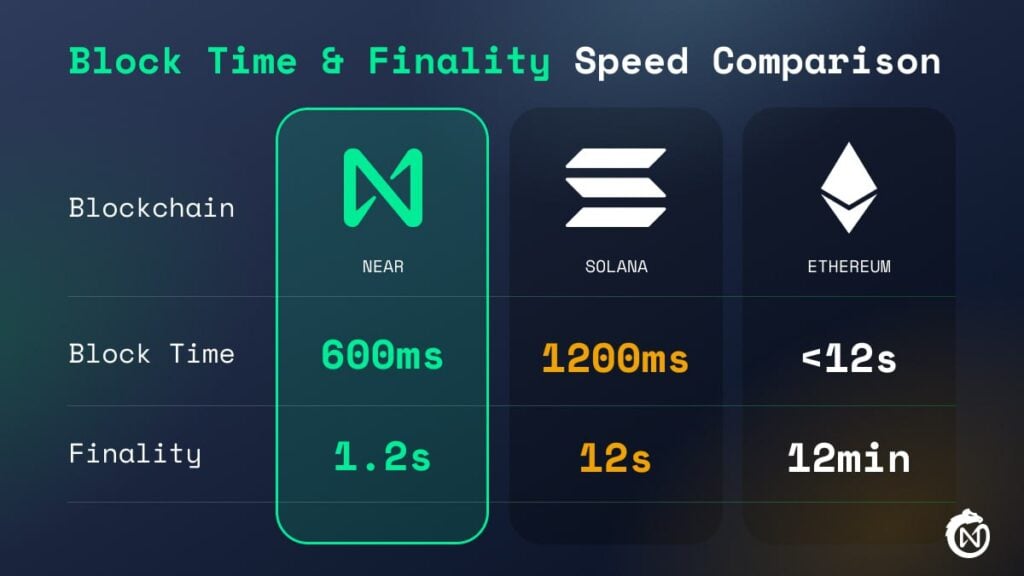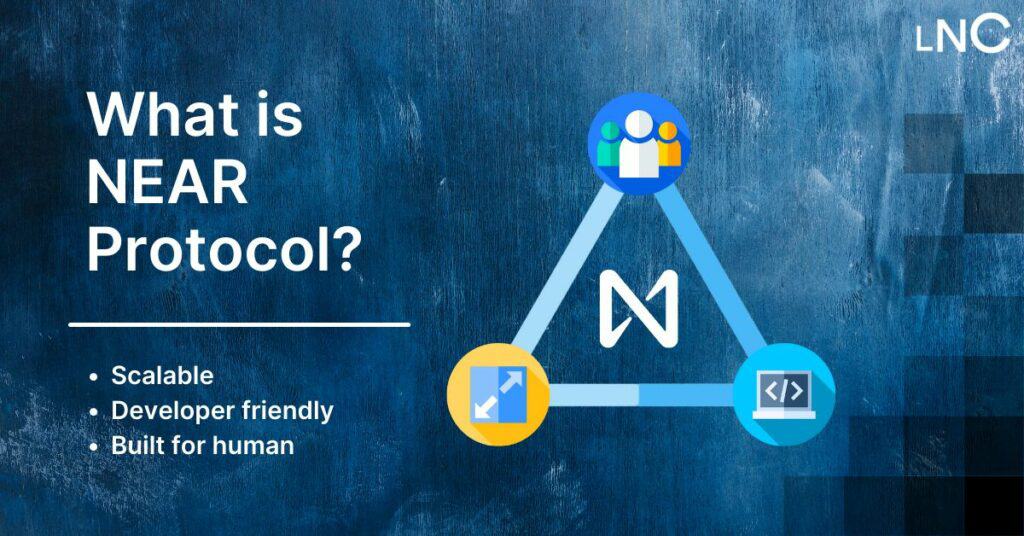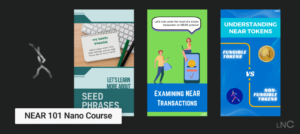In a digital economy where every millisecond matters, NEAR Protocol’s recent upgrade represents a generational leap in blockchain infrastructure. The rollout of 600ms block times and 1.2-second finality isn’t just a technical milestone—it’s a signal that Web3 is stepping into real-time territory, unlocking high-speed, composable applications for both human and machine users.
🚀 What Did NEAR Just Achieve?
1. 600 Millisecond Block Production
This means:
-
A new block is produced every 0.6 seconds.
-
Transactions get included in the chain in near-real-time.
-
Reduces latency for any dApp, smart contract, or AI agent.
Compare that with:
-
Solana: Takes 1.6 seconds for block confirmation.
-
Ethereum L2s: Need at least 12 seconds for optimistic inclusion.
This is 2x–20x faster than competitors with stronger guarantees.
2. 1.2 Second Finality
“Finality” is the point after which a transaction cannot be reversed without slashing someone’s stake (i.e., serious consequences).
-
NEAR’s Doomslug consensus enables this by marking a block as final when it’s built upon.
-
Combined with optimistic blocks, shards no longer wait on each other—cutting time nearly in half.
In contrast:
-
Solana requires 4 blocks (~10s) for strong finality.
-
Ethereum L2s rely on L1 Ethereum finality (~13 minutes in optimistic rollups, longer in zk-rollups).

Takeaway: NEAR isn’t just fast—it’s securely fast.
🔧 What Enabled This Leap?
🧱 Optimistic Blocks (Nightshade 2.0)
-
Allows shards to process transactions before the parent block is finalized.
-
“Optimistic” means assuming success unless proven otherwise—similar to optimistic rollups but within the L1 itself.
-
Doubles the throughput of sharded chains by minimizing cross-shard coordination latency.
⛓️ Doomslug Consensus
-
Provides one-block finality under normal network conditions.
-
Malicious rollbacks are economically punishable (slashable).
-
Think of it as Ethereum’s “finality” but within seconds, not epochs.
🤖 Why This Matters for Developers and AI Agents
1. Real-Time Composability
-
Multi-step transactions can finalize in ~1.2s.
-
You can chain DeFi trades, game logic, or supply chain updates without delay.
2. Autonomous Agents
-
AI agents (think: on-chain chatbots, robotic market makers, or predictive oracles) can act and receive feedback in real-time.
-
Enables true on-chain automation loops that were impossible before due to latency.
3. Seamless User Experience
-
No more designing around slow confirmations.
-
Users get instant feedback and execution.
-
No need to explain “why your transaction is pending.”
🆚 NEAR vs Other Chains: No More Tradeoffs?
Blockchain development has long been constrained by the blockchain trilemma: balancing speed, security, and decentralization. Here’s why NEAR’s architecture may actually break the triangle:
✅ Speed:
-
Faster than Solana with stronger guarantees.
-
Leaves L2s and Ethereum in the dust.
✅ Security:
-
Doomslug + Nightshade ensure economic finality.
-
Sharded validators with slashing create real deterrents.
✅ Scalability:
-
Dynamic sharding ensures sustainable throughput as usage grows.
-
Unlike Solana (monolithic), NEAR can parallelize state changes.
🧪 What Could This Enable?
Think beyond dApps. Here’s what becomes practical now:
-
Autonomous DAOs that respond instantly to market conditions.
-
Decentralized social media with live user updates and composable reactions.
-
Real-time gaming where player actions sync across chain with no lag.
-
Flashbot-less DeFi with latency arbitrage disappearing.
-
AI agents that react to or trigger events across blockchains via bridges.
🔭 What’s Coming Next?
NEAR hinted at even faster block times (~200ms) by end of 2025. If that happens:
-
It will enter real-time system territory (e.g., low-latency trading, robotics, IoT).
-
Combined with zk-bridges or chain abstraction, NEAR could act as a real-time execution layer for the entire multichain ecosystem.
✅ Pros and Cons of NEAR’s Update
Pros:
-
Unmatched speed: Best real-world finality numbers in Web3 today.
-
Secure execution: Finality via Doomslug means actual guarantees.
-
Better dev UX: No need to design around confirmations.
-
Scalable by design: Nightshade sharding evolves with demand.
-
AI and real-time ready: Ideal for future of autonomous apps.
Cons:
-
Still early in tooling: Dev ecosystem not as mature as Ethereum or Solana.
-
Bridge risk: Composability with other chains still depends on secure interoperability layers.
-
Market perception: NEAR’s performance isn’t yet widely recognized or priced in.
-
Latency-sensitive edge cases: While finality is fast, inbound/outbound bridge txs could bottleneck multi-chain AI flows.
💡 Unasked but Crucial: Strategic Implications
-
Multichain Execution Hubs: NEAR could act as the low-latency execution backend for zkRollups or DA apps on other L1s.
-
AI + Crypto Fusion: Real-time agents (think auto-finance bots, autonomous warehouses) need NEAR’s level of finality to be viable.
-
DeFi Redesign: Low-latency chains can eliminate traditional front-running protection assumptions (e.g., MEV minimization may need revisiting).
-
Latency Arbitrage: Builders on slower chains may lose to NEAR-native dApps simply due to physical execution speed.
🔚 Final Word
NEAR’s latest update isn’t just an optimization—it’s a paradigm shift. For the first time, developers don’t need to choose between fast, secure, and scalable—they get all three. In an era where AI agents will transact, reason, and learn on-chain, NEAR is arguably the only L1 built to handle this next-generation load in real-time.
Updated: May 13, 2025




👍👍
🧑 100% userIndeed, this will change web3/blochain paradigm. Fingers crossed 🤞